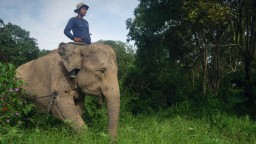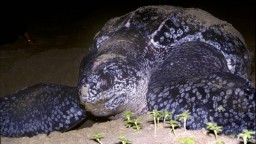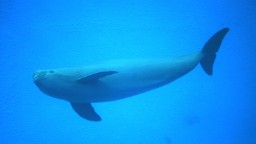

One million species threatened with extinction because of humans
By Isabelle Gerretsen, CNN
Updated 0935 GMT (1735 HKT) May 7, 2019
Story highlights
- The landmark UN report paints a bleak picture of a planet ravaged by an ever-growing human population.
- "We should act now to avoid a dire future," scientists warn.
(CNN)One million of the planet's eight million species are threatened with extinction by humans, scientists warned Monday in what is described as the most comprehensive assessment of global nature loss ever.
Their landmark report paints a bleak picture of a planet ravaged by an ever-growing human population, whose insatiable consumption is destroying the natural world.
The global rate of species extinction "is already tens to hundreds of times higher than it has been, on average, over the last 10 million years," according to the Intergovernmental Science-Policy Platform on Biodiversity and Ecosystem Services (IPBES), a UN committee, whose report was written by 145 experts from 50 countries.
Shrinking habitat, exploitation of natural resources, climate change and pollution are the main drivers of species loss and are threatening more than 40% of amphibians, 33% of coral reefs and over a third of all marine mammals with extinction, the IPBES report said.
"The health of ecosystems on which we and all other species depend is deteriorating more rapidly than ever," said Sir Robert Watson, IPBES chair, adding that "transformative change" is needed to save the planet.
The report comes six months after the UN Intergovernmental Panel on Climate Change (IPCC)warned that the world has less than 12 years to avoid catastrophic levels of global warming.
In the same way that the IPCC report put the climate crisis on the political agenda, the authors of the IPBES report hope that it will thrust nature loss into the global spotlight.

Photos: The world's critically endangered species
Sumatran elephant – Sumatran elephants come into conflict with humans due to the rapid expansion of palm oil plantations which destroy their habitat.
Hide Caption
7 of 12

Photos: The world's critically endangered species
Sumatran tiger – Sumatran tigers are the smallest surviving tiger species and are protected by law in Indonesia. But despite increased efforts in tiger conservation, they remain critically endangered.
Hide Caption
8 of 12

Photos: The world's critically endangered species
Leatherback turtle – Leatherback turtles are the largest sea turtle species and also one of the most migratory, crossing both the Atlantic and Pacific Oceans. According to WWF, their numbers have seriously declined during the last century as a result of intense egg collection and fishing.
Hide Caption
9 of 12

Photos: The world's critically endangered species
Western lowland gorilla – Western lowland gorillas are critically endangered species. Because of poaching and disease, their numbers have declined by more than 60% over the last 20 to 25 years, according to the WWF's report.
Hide Caption
10 of 12

Photos: The world's critically endangered species
Yangtze finless porpoise – The population of Yangtze finless porpoises is declining rapidly. The freshwater dolphins are suffering due to pollution and hunting.
Hide Caption
11 of 12

Photos: The world's critically endangered species
Sumatran rhino – Sumatran rhino populations are extremely threatened by poaching, the WWF says.
Hide Caption
12 of 12

Photos: The world's critically endangered species
Black rhino – Poachers and hunters are responsible for the early decline of black rhino population. The world's animal population has halved in 40 years as humans put unsustainable demands on Earth, according to a 2014 report from the World Wide Fund for Nature.
Hide Caption
1 of 12

Photos: The world's critically endangered species
Hawksbill sea turtle – The existence of Hawksbill sea turtles have been traced back 100 million years. Now they are critically endangered, the WWF says.
Hide Caption
2 of 12

Photos: The world's critically endangered species
Mountain gorilla – As humans move more into the mountain gorillas' territory, the gorillas have been pushed farther up into the mountains, forcing them to endure dangerous and sometimes deadly conditions, the WWF report on the planet says.
Hide Caption
3 of 12

Photos: The world's critically endangered species
Amur leopard – Amur Leopard, a rare species of leopard living on the borders of Russia and China, was the winner of the 2013 WWF award dedicated to the positive evolution of an endangered species, but remains critically endangered.
Hide Caption
4 of 12

Photos: The world's critically endangered species
Sumatran orangutan – Sumatran orangutans are losing their natural habitats to mining, palm oil and paper plantations.
Hide Caption
5 of 12

Photos: The world's critically endangered species
South China tiger – The South China tiger is considered "functionally extinct," as it has not been sighted in the wild for more than 25 years.
Hide Caption
6 of 12

Photos: The world's critically endangered species
Sumatran elephant – Sumatran elephants come into conflict with humans due to the rapid expansion of palm oil plantations which destroy their habitat.
Hide Caption
7 of 12

Photos: The world's critically endangered species
Sumatran tiger – Sumatran tigers are the smallest surviving tiger species and are protected by law in Indonesia. But despite increased efforts in tiger conservation, they remain critically endangered.
Hide Caption
8 of 12

Photos: The world's critically endangered species
Leatherback turtle – Leatherback turtles are the largest sea turtle species and also one of the most migratory, crossing both the Atlantic and Pacific Oceans. According to WWF, their numbers have seriously declined during the last century as a result of intense egg collection and fishing.
Hide Caption
9 of 12

Photos: The world's critically endangered species
Western lowland gorilla – Western lowland gorillas are critically endangered species. Because of poaching and disease, their numbers have declined by more than 60% over the last 20 to 25 years, according to the WWF's report.
Hide Caption
10 of 12

Photos: The world's critically endangered species
Yangtze finless porpoise – The population of Yangtze finless porpoises is declining rapidly. The freshwater dolphins are suffering due to pollution and hunting.
Hide Caption
11 of 12

Photos: The world's critically endangered species
Sumatran rhino – Sumatran rhino populations are extremely threatened by poaching, the WWF says.
Hide Caption
12 of 12

Photos: The world's critically endangered species
Black rhino – Poachers and hunters are responsible for the early decline of black rhino population. The world's animal population has halved in 40 years as humans put unsustainable demands on Earth, according to a 2014 report from the World Wide Fund for Nature.
Hide Caption
1 of 12

Photos: The world's critically endangered species
Hawksbill sea turtle – The existence of Hawksbill sea turtles have been traced back 100 million years. Now they are critically endangered, the WWF says.
Hide Caption
2 of 12

Photos: The world's critically endangered species
Mountain gorilla – As humans move more into the mountain gorillas' territory, the gorillas have been pushed farther up into the mountains, forcing them to endure dangerous and sometimes deadly conditions, the WWF report on the planet says.
Hide Caption
3 of 12

Photos: The world's critically endangered species
Amur leopard – Amur Leopard, a rare species of leopard living on the borders of Russia and China, was the winner of the 2013 WWF award dedicated to the positive evolution of an endangered species, but remains critically endangered.
Hide Caption
4 of 12

Photos: The world's critically endangered species
Sumatran orangutan – Sumatran orangutans are losing their natural habitats to mining, palm oil and paper plantations.
Hide Caption
5 of 12

Photos: The world's critically endangered species
South China tiger – The South China tiger is considered "functionally extinct," as it has not been sighted in the wild for more than 25 years.
Hide Caption
6 of 12












Managing the land
Just as with climate change, humans are the main culprits of biodiversity damage, altering 75% of Earth's land and 66% of marine ecosystems since pre-industrial times, according to the report.
The report emphasizes the disastrous impact of population growth and rising demand. It notes that the world's population has more than doubled (from 3.7 to 7.6 billion) in the last 50 years, and gross domestic product per person is four times higher.
More than a third of the world's land and 75% of freshwater supplies are used for crop or livestock production, it noted.
"[There is] very little of the planet left that has not been significantly altered by us," Sandra Diaz, co-author of the report and professor of ecology at the University of Córdoba, told CNN. "We need to act as stewards for life on Earth."
Diaz said countries in the Global North are particularly to blame for nature damage due to their "unsustainable" levels of consumption, especially when it comes to fishing and logging.
In 2015, a third of marine stocks were being fished at unsustainable levels and the amount of raw timber being harvested has increased by almost half since 1970, with up to 15% of it cut illegally, according to the report.
Marine plastic pollution has increased tenfold since 1980, with an average of 300-400 million tons of waste dumped into the world's waters annually.
Pollution entering coastal ecosystems has produced more than 400 ocean "dead zones," totalling an area bigger than the United Kingdom. These areas are so starved of oxygen they can barely support marine life.
Key numbers from the report
- Around 10% of insect species are threatened with extinction.
- 300% increase in global food crop production since 1970.
- 23% of land areas have reduced agricultural productivity due to land degradation.
- About 25% of greenhouse gas emissions are caused by land clearing, crop production and fertilization.
- Around half of all live coral reef cover lost since the 1870s.
- Urban areas have grown more than 100% since 1992.
- 25 million km of new paved roads expected by 2050.
It's not too late
Despite the ominous picture "it is not too late to make a difference, but only if we start now at every level from local to global," said Watson, adding that this would require an overhaul of economic systems and a shift in political and social mindsets.
Diaz said that governments should implement drastic changes now to avoid a "dire future" in 10-20 years when their "food and climate security [is] in jeopardy."
Climate change has already contributed to biodiversity loss by triggering more extreme weather events and rising sea levels and will exacerbate the crisis over the coming decades, the report noted.
The report says we can improve sustainability in farming by planning landscapes so that they provide food while also supporting the species that live there. Other suggestions include reforming supply chains and reducing food waste.
When it comes to healthy oceans, the report recommends effective fishing quotas, designated protected areas and reducing the pollution that runs off from the land into the sea, among other actions.
Rachel Warren, professor of global change and environmental biology at the University of East Anglia, told CNN that governments should focus on "the restoration of destroyed or degraded ecosystems with native species [as this] helps to address both biodiversity loss and climate change."
"Biodiversity underpins ecosystem services such as pollination, flood prevention, water and air purification, and soil conservation. We are in danger of losing vital ecosystem services which will have major negative consequences for human civilization," she said.
Guenter Mitlacher, director of international biodiversity policy at the World Wildlife Fund (WWF), said, "Ours is the first generation with the tools to see how the Earth has been changed by people at our own peril. We're also the last generation with the opportunity to influence the course of many of those changes. Now is the time to act, not halfheartedly and incrementally but drastically and boldly."
The IPBES report comes ahead of two high-level summits in 2020 where world leaders will scale up their climate and environment protection goals. That is when China will host the UN convention on biodiversity to set new 20-year targets and when the signatories of the 2015 Paris Agreement to keep global warming to less than 2 degrees will revise their commitments.













No comments:
Post a Comment